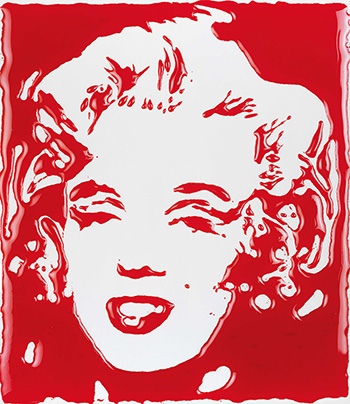PROVENANCE:
Galerie Xippas, Paris
Private collection, Europe
EXHIBITED:
Vik Muniz, Irish Museum of Contemporary Art, Dublin, April 2-June 13, 2004
Pictures of People, BALTIC Centre for Contemporary Art, Gateshead, January 31-April 15, 2007 (another edition exhibited)
Vik Muniz Reflex, Musée d’art contemporain de Montréal, Montreal, October 4, 2007-January 6, 2008 (another edition exhibited)
Vik Muniz: Pictures of Anything, Tel Aviv Museum of Art, Tel Aviv, March 27- August 2, 2014 (another edition exhibited)
ILLUSTRATED:
Vik Muniz “After Warhol”, exh. cat., Galerie Xippas, Paris, 2000, color illustrated, p. 29 (another edition).
Vik Muniz, exh. cat., Centro Galego de arte Contemporanea, Santiago de Compostela, 2003-2004, color illustrated, pp. 142-143 (another edition)
J. Elkins, M. Dos Anjos and S. Rice, Vik Muniz: Obra Incompleta - Incomplete Works, Rio de Janeiro, 2004, color illustrated, p. 54 (another edition)
Vik Muniz “Le Museé Imaginaire”, exh. cat., Collection Lambert, Avignon, 2006, color illustrated, p. 115 (another edition)
P. Corrêa do Lago (ed.), Vik Muniz: Obra Completa 1987- 2009: Catálogo Raisonné, Rio de Janeiro 2009, color illustrated, p. 308 (another edition)
Galerie Xippas, Paris
Private collection, Europe
EXHIBITED:
Vik Muniz, Irish Museum of Contemporary Art, Dublin, April 2-June 13, 2004
Pictures of People, BALTIC Centre for Contemporary Art, Gateshead, January 31-April 15, 2007 (another edition exhibited)
Vik Muniz Reflex, Musée d’art contemporain de Montréal, Montreal, October 4, 2007-January 6, 2008 (another edition exhibited)
Vik Muniz: Pictures of Anything, Tel Aviv Museum of Art, Tel Aviv, March 27- August 2, 2014 (another edition exhibited)
ILLUSTRATED:
Vik Muniz “After Warhol”, exh. cat., Galerie Xippas, Paris, 2000, color illustrated, p. 29 (another edition).
Vik Muniz, exh. cat., Centro Galego de arte Contemporanea, Santiago de Compostela, 2003-2004, color illustrated, pp. 142-143 (another edition)
J. Elkins, M. Dos Anjos and S. Rice, Vik Muniz: Obra Incompleta - Incomplete Works, Rio de Janeiro, 2004, color illustrated, p. 54 (another edition)
Vik Muniz “Le Museé Imaginaire”, exh. cat., Collection Lambert, Avignon, 2006, color illustrated, p. 115 (another edition)
P. Corrêa do Lago (ed.), Vik Muniz: Obra Completa 1987- 2009: Catálogo Raisonné, Rio de Janeiro 2009, color illustrated, p. 308 (another edition)
